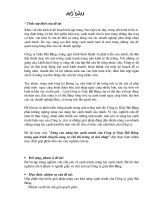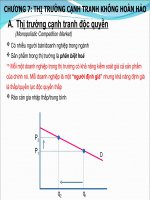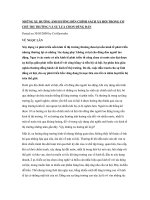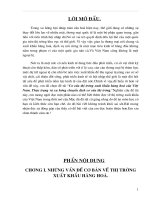Chương 10 Cơ cấu thị trường và cạnh tranh không hoàn hảo pdf
Bạn đang xem bản rút gọn của tài liệu. Xem và tải ngay bản đầy đủ của tài liệu tại đây (117.62 KB, 20 trang )
Chapter 10
Market structure and imperfect competition
David Begg, Stanley Fischer and Rudiger Dornbusch, Economics,
6th Edition, McGraw-Hill, 2000
Power Point presentation by Peter Smith
10.2
Most markets fall between the two extremes
of monopoly and perfect competition
■
An imperfectly competitive firm
–
would like to sell more at the going
price
–
faces a downward-sloping demand
curve
–
recognises its output price depends on
the quantity of goods produced and
sold
10.3
Imperfect competition
■
An oligopoly
–
an industry with a few producers
–
each recognizing that its own price depends both
on its own actions and those of its rivals.
■
In an industry with monopolistic competition
–
there are many sellers producing products that
are close substitutes for one another
–
each firm has only limited ability to influence its
output price.
10.4
Market structure
Number
of firms
Ability to
affect
price
Entry
barriers
Example
Perfect competition
Imperfect competition:
Monopolistic competition
Oligopoly
Monopoly
Many
Many
Few
One
Nil
Small
Medium
Large
None
None
Some
Huge
Fruit stall
Corner shop
Cars
Post Office
10.5
The minimum efficient scale and
market demand
■
The minimum efficient scale (mes) is the output at
which a firm’s long-run average cost curve stops
falling.
■
The size of the mes relative to market demand
has a strong influence on market structure
D
LAC
1
LAC
2
LAC
3
Output
£
10.6
Monopolistic competition
■
Characteristics:
–
many firms
–
no barriers to entry
–
product differentiation
■
so the firm faces a downward-sloping
demand curve
–
The absence of entry barriers means
that profits are competed away
10.7
Monopolistic competition (2)
■
Firms end up in TANGENCY
EQUILIBRIUM, making
normal profits
■
Firms do not operate at
minimum LAC
■
Price exceeds marginal cost
■
Unlike perfect competition,
the firm here is eager to sell
more at the going market
price.
P
1
=AC
1
£
Output
Q
1
D
MR
AC
MC
F
10.8
Oligopoly
■
A market with a few sellers
■
The essence of an oligopolistic
industry is the need for each firm to
consider how its own actions affect
the decisions of its relatively few
competitors.
■
Oligopoly may be characterized by
collusion or by non-co-operation
10.9
Collusion and cartels
■
COLLUSION
–
an explicit or implicit agreement between
existing firms to avoid or limit
competition with one another
■
CARTEL
–
is a situation in which formal agreements
between firms are legally permitted
➡
e.g. OPEC
10.10
Collusion is difficult if:
■
There are many firms in the industry
■
The product is not standardized
■
Demand and cost conditions are
changing rapidly
■
There are no barriers to entry
■
Firms have surplus capacity
10.11
The kinked demand curve (1)
Q
0
P
0
Quantity
£
Consider how a firm may
perceive its demand curve
under oligopoly.
It can observe the current
price and output,
but must try to anticipate
rival reactions to any
price change.
10.12
Q
0
P
0
Quantity
£
The kinked demand curve (2)
The firm may expect rivals
to respond if it reduces
its price, as this will be seen
as an aggressive move
… so demand in response
to a price reduction is likely
to be relatively inelastic
The demand curve will
be steep below P
0
.
D
10.13
The kinked demand curve (3)
Q
0
P
0
Quantity
£
D
…but for a price increase
rivals are less likely to
react,
so demand may be
relatively elastic
above P
0
so the firm perceives
that it faces a kinked
demand curve.
10.14
The kinked demand curve (4)
Q
0
P
0
Quantity
£
D
Given this perception, the
firm sees that revenue will
fall whether price is increased
or decreased,
so the best strategy is to keep
price at P
0
.
Price will tend to be stable,
even in the face of an increase
in marginal cost.
10.15
Game theory: some key terms
■
Game
–
a situation in which intelligent decisions
are necessarily interdependent
■
Strategy
–
a game plan describing how the player will
act or move in every conceivable situation
■
Dominant strategy
–
where a player’s best strategy is
independent of those chosen by others
10.16
The Prisoners’ Dilemma Game
Consider two firms in a duopoly each with a choice
of producing “high” or “low” output:
Firm B output
High Low
High 1 1 3 0
Firm A
output
Low 0 3 2 2
10.17
The Prisoners’ Dilemma
■
Each firm has a dominant strategy to
produce high
■
so they make 1 unit profit each
■
but they would both be better off
producing low
–
as long as they can be sure that the other
firm also produces low.
■
So collusion can bring mutual benefits
■
but there is incentive for each firm to
cheat
10.18
More on collusion
■
The probability of cheating may be
affected by agreement or threats
■
Pre-commitment
–
an arrangement, entered voluntarily,
restricting future options
■
Credible threat
–
a threat which, after the fact, is optimal
to carry out
10.19
Contestable markets
■
A contestable market is characterized
by free entry and free exit
–
no sunk costs
–
allows h it-an d - run entry
■
Contestability may constrain
incumbent firms from exploiting their
market power.
10.20
Strategic entry deterrence
■
Some entry barriers are deliberately
erected by incumbent firms:
–
threat of predatory pricing
–
spare capacity
–
advertising and R&D
–
product proliferation
■
Actions that enforce sunk costs on
potential entrants









